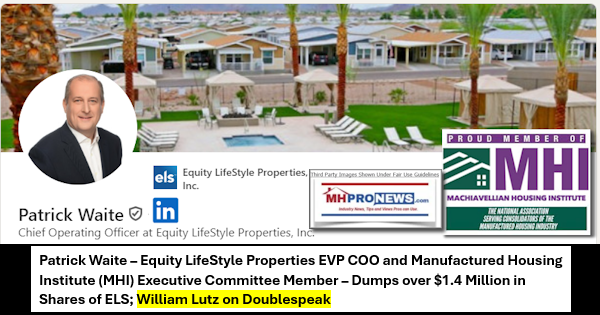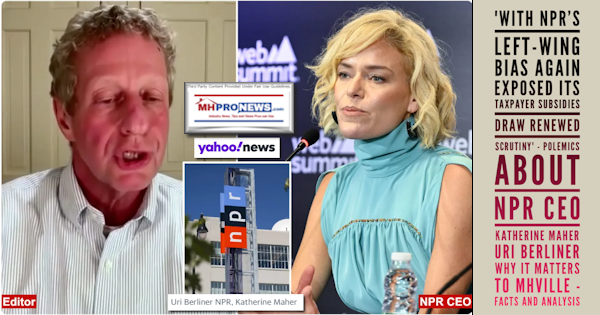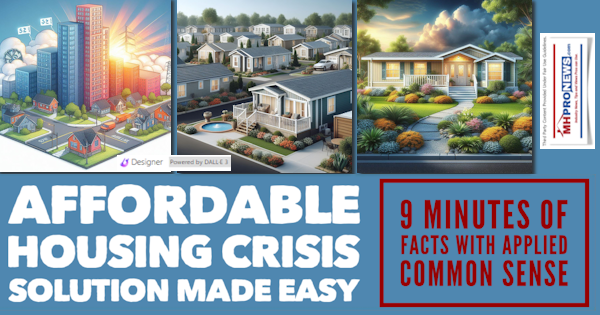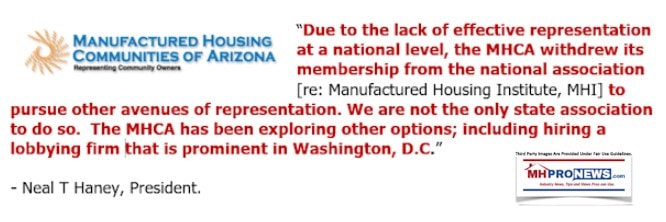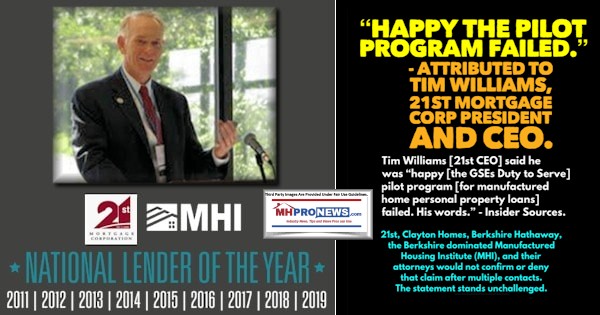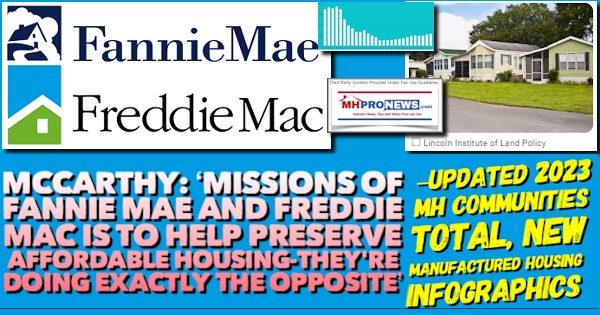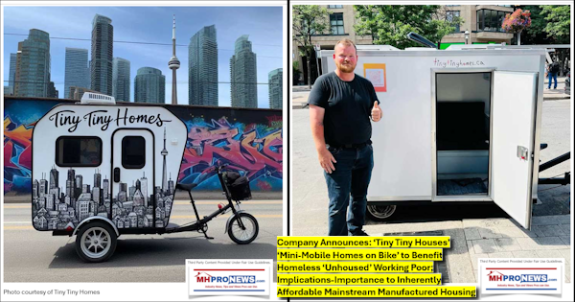According to the Internal Revenue Service (IRS), nonprofits are typically required to file an IRS Form 990 every year in order to maintain their nonprofit status. According to GuideStar page about the “Manufactured Housing Institute” (MHI) had GROSS RECEIPTS of “$6,432,765” and ASSETS of “$8,789,022.” Per the MHI IRS form 990 linked here on page 2, one of the remarks made by MHI leaders under penalties of perjury that describes MHI nonprofit actives are the following remarks. “ENABLED MHI TO BE A RECOGNIZED SOURCE OF INFORMATION REGARDING THE MANUFACTURED HOUSING INDUSTRY THROUGH ACCUMULATION AND DISTRIBUTION OF INDUSTRY INFORMATION AND STATISTICS TO GOVERNMENT OFFICIALS, THE MEDIA, AND GENERAL PUBLIC. ALSO OFFERED PROGRAMS DESIGNED TO INCREASE INDUSTRY SALES NATIONWIDE BY ENCOURAGING POLICIES TO DEVELOP MANUFACTURED HOUSING COMMUNITIES, PARKS, AND PRIVATE LOT PLACEMENTS.” (Masthead on MHProNews Note: the use of all caps above and herein when quoting MHI’s 990 are in the original.)
So, MHI claims that they are working to “increase [manufactured home] industry sales nationwide by encouraging policies to develop manufactured housing communities, parks, and private lot placements.”
Also on page 2 of that MHI IRS Form 990 is this; MHI: “SOUGHT TO OBTAIN REASONABLE FEDERAL CONSTRUCTION AND SAFETY CODES AND STANDARDS FOR THE MANUFACTURED HOUSING INDUSTRY, OFFERED PROGRAMS TO ENHANCE THE RECOGNITION AND IMAGE OF THE MANUFACTURED HOUSING INDUSTRY, OFFERED PROGRAMS AND DISTRIBUTED COMMUNITY DEVELOPMENT INFORMATION TO PROMOTE THE SUCCESSFUL OPERATION OF MANUFACTURED HOME COMMUNITIES.”
The MHI’s IRS Form 990 was signed by: “MARK BOWERSOX PRESIDENT” under a sworn statement: “Under penalties of perjury, I declare that I have examined this return, including accompanying schedules and statements, and to the best of my knowledge and belief, it is true, correct, and complete. Declaration of preparer (other than officer) is based on all information of which preparer has any knowledge.”
The MHI form 990 also said: “THE FINAL 990 IS SHARED WITH THE EXECUTIVE COMMITTEE.”
So, the MHI executive committee, which is currently made up of the first 5 individuals named here, are made aware of the remarks in this annual filing. Indeed, as board members, they are accountable along with Bowersox and others involved in the annual IRS 990 reporting process.
Using their own stated metric to “increase [manufactured home] industry sales nationwide by encouraging policies to develop manufactured housing communities, parks, and private lot placements,” how is MHI doing?
- The current year-to-date pace of manufactured housing production in 2023 (see link here and more info further below) is under 25 percent of the new manufactured home production and shipments achieved in 1998.
- New manufactured home production is also down significantly since 2022.
Oddly, those bullets are true despite the fact that Congress enacted a widely bipartisan piece of legislation in 2000 that aimed to increase manufactured housing as an important part of the affordable housing crisis.
That legislation was entitled by Congress as the Manufactured Housing Improvement Act of 2000 (MHIA). The law included these “Findings and purposes.”
 Congress finds that—
Congress finds that—
(1) manufactured housing plays a vital role in meeting the housing needs of the Nation; and
(2) manufactured homes provide a significant resource for affordable homeownership and rental housing accessible to all Americans.”
From the same MHIA are these “purposes.”
 Purposes
Purposes
The purposes of this chapter are—
(1) to protect the quality, durability, safety, and affordability of manufactured homes;
(2) to facilitate the availability of affordable manufactured homes and to increase homeownership for all Americans;
(3) to provide for the establishment of practical, uniform, and, to the extent possible, performance-based Federal construction standards for manufactured homes;
(4) to encourage innovative and cost-effective construction techniques for manufactured homes;
(5) to protect residents of manufactured homes with respect to personal injuries and the amount of insurance costs and property damages in manufactured housing, consistent with the other purposes of this section;
(6) to establish a balanced consensus process for the development, revision, and interpretation of Federal construction and safety standards for manufactured homes and related regulations for the enforcement of such standards;
(7) to ensure uniform and effective enforcement of Federal construction and safety standards for manufactured homes; and
(8) to ensure that the public interest in, and need for, affordable manufactured housing is duly considered in all determinations relating to the Federal standards and their enforcement.”
Documentary Evidence from Key MHI Members Contradict MHI 990 and Current and Years of Prior MHI Website Claims
MHI is well aware of the above, because they and the Manufactured Housing Association for Regulatory Reform (MHARR) worked together to get that bill into federal law. Even those who came years after the Manufactured Housing Improvement Act was enacted are supposed to know these things, that too is part of their commitment under the IRS Form 990 assertions.
While MHI has repeatedly stated for years that it is working for “all segments” of the manufactured housing industry, the evidence indicates that they posture working on behalf of all segments of our industry and rather are working as a tool for consolidation of the industry in a manner that appears to violate state and/or federal laws.
Among the MHI board and executive committee members at the time of this writing are management and corporate leaders for publicly traded Equity LifeStyle Properties (ELS), Sun Communities (SUI), and Flagship Communities (MHC-UN.TO) Real Estate Investment Trust (REIT).
Consider these graphics that follow from each of those 3 publicly traded MHI member companies.
Note: to expand this image and others below to a larger or full size,
see the instructions
below the graphic below or click the image and follow the prompts.


The graphics above are from recent 2023 investor relations presentations (investor “pitch deck”) which are supposed to provide accurate information. Starting in 2020, Flagship framed their version of their investor pitch in a similar fashion (see below).

In each of the three publicly traded firms examined above which are represented by the current MHI board, all three have quite similar remarks. The importance of that will be unpacked herein.
The Significance of the Above
1. Recall that MHI leaders stated in their 990 under penalties of perjury that their purpose is to “increase [manufactured home] industry sales nationwide by encouraging policies to develop manufactured housing communities, parks, and private lot placements.”
2. But those statements in the MHI 990 are in stark contrast to remarks by several MHI board members from the land lease manufactured home communities (MHCs) sector who as the illustrations above demonstrate said something quite different AND at odds with the goal to increase “develop[ment] of manufactured housing communities, parks, and private lot placements” that should “increase [manufactured home] industry sales nationwide.”
To save readers the need to scroll back above, these pull quotes are from those three MHI member firm’s Investor Relations (IR) pitch decks are as follows.
- Per Sun Communities (SUI): “Virtually no new supply [of land lease manufactured home communities or MHCs] has been added for years” is part of their investment thesis based on “Compelling Supply Demand Fundamentals.” Meaning, because there is “virtually no new supply” those existing communities are more in demand.
- Per Equity LifeStyle Properties (ELS): “Supply Constrained Asset class” where “There has been limited MH development in the U.S. in the past 20 years.” “Growing demand coupled with almost no new supply is a strategic advantage for ELS.“
- Per Flagship Communities (MHC-UN.TO): “Fragmented Industry with High Barriers to Entry and Imbalanced Supply and Demand Dynamics.”
- All three MHI member firms have used similar language that made it clear that their investment thesis is that they benefit from a lack of new manufactured home community (MHC) developing.
In the headline for this MHProNews Masthead report and analysis are the words “prima facie” case. Investopedia said about “prima facie” that: “In both civil and criminal law, the term is used to denote that, upon initial examination, a legal claim has sufficient evidence to proceed to trial or judgment.”
Some reading this might muse, that may be interesting to some in the artificially diminished manufactured home industry (a.k.a. MHVille), but why does this matter to most Americans? Consider the following.
Two Trillion Dollars
In as much as millions of more housing units are needed, the lack of affordable housing impacts essentially the entire U.S. population, even if they never plan to own a manufactured home.
Indeed, Cavco Industries, whose president and CEO William “Bill” Boor happens to be MHI’s new chairman, asserted earlier this year that the lack of affordable housing is a $2 trillion dollar drag on the U.S. Gross Domestic Product (GDP). Boor’s not the first to make such a claim, as during the Obama-Biden administration two NBER (National Bureau of Economic Research) experts similarly said that the negative economic drag on U.S. GDP was some $2 trillion dollars annually.
Doing the math of dividing the U.S. population into that lost $2 trillion dollars in GDP means that every man, woman, and child in the U.S. have been harmed to the tune of $6000 per person annually. That means that a family of four over the course of a decade has lost nearly a quarter million dollars ($240,000).
Top Cause of Homelessness
Note that several sources will be cited in this fact- and evidence-packed report and analysis, and those sources span the left-right political and social divides. The lack of affordable housing in the U.S. is ideally a nonpartisan or bipartisan issue.
But as another example of the harm caused by a lack of affordable housing, according to PBS affiliate, Oregon Public Broadcasting (OPB), the lack of affordable housing is purportedly the top cause for homelessness. Billions are spent annually at the federal, state, and local level due to homelessness and related services. Those are areas that taxpayers could be saving that money if the affordable housing crisis were solved largely by using free market principles.
When industry members – including, but not limited to Cavco and UMH Properties – recognize these issues, why aren’t they being properly promoted by MHI on their website? Why is there a disconnect between the narrative that MHI is working for “all segments” of the industry, when several of their member firms are apparently interested in limiting the industry – at least at this time – in order to foster further consolidation at a relatively discounted price? Producers of manufactured homes that are MHI members, as well as community operators, have made the point that consolidation is a goal in their various remarks and presentations to investors.
MHI Leaders, Attorneys
The leadership of MHI has been given several opportunities to address these issues, as have several of their organization’s attorneys. They have repeatedly declined comment, even though attorney David Goch made clear that if the organization (MHI) is wrongfully disparaged, they vowed to take action in defense of their supposedly good name.
In as much as the Securities and Exchange Commission (SEC) has already successfully settled a case involving one of those MHI members and some of their leaders, and several class action antitrust lawsuits have been launched that name several MHI member companies, it ought to be more obvious than ever that evidence exists for a formal and hopefully transparent inquiry by lawmakers and public officials entrusted with enforcement of the laws apparently being violated by MHI member companies.
Digging Deeper – Eye Opening…the Manufactured Housing Improvement Act of 2000 (MHIA) and MHI
To grasp the ‘big picture’ evidence that something has gone terribly wrong in manufactured housing, keep in mind that Congress enacted widely bipartisan legislation in 2000 that was signed into law by then President William Jefferson “Bill” Clinton (D). As was noted above, that law was dubbed the Manufactured Housing Improvement Act of 2000 (MHIA or some call it the 2000 Reform Law).
Also keep in mind that manufactured housing has been praised by a range of third-party research that often disproves relatively common concerns in the public mind.




The MHIA provided more consumer protections, which it did reasonably well. The relative scarcity of reported claims that go to dispute resolution every year is a good indicator that the quality of manufactured housing is up to HUD’s national standards.
Per Bing AI on 11.14.2023: “…the relatively modest number of requests for dispute resolution suggests that manufactured homes are routinely achieving the standards set by HUD 4.”
However, that 2000 Reform Law that revised the 1974 act which gave us the HUD Code for manufactured housing was supposed to boost the supply of more affordable housing by increasing the public’s access to and thus ability to buy a manufactured home. The pull quote below is from the findings and purposes of the law cited in context further above.
- “(2) to facilitate the availability of affordable manufactured homes and to increase homeownership for all Americans;”
Beyond the MHIA, other legislation at least potentially useful for manufactured housing was later enacted. More specifically, the Housing and Economic Recovery Act (HERA) of 2008 – also aimed to support the access to more affordable financing for manufactured housing. HERA 2008 called it the “Duty to Serve” (DTS) manufactured housing. There were already other federal loan programs that were supposed to make manufactured home purchases more affordable.
Despite those largely bipartisan federal laws, instead of the manufactured home market growing, the manufactured home market shrank instead. See the graphic and facts further below.
Stop and think. Two significant pieces of legislation were enacted that were supposed to grow the manufactured housing market. The industry contracted instead. That should beg the question: why did the manufactured housing market shrink? What’s going on that explains what has happened to once far larger manufactured housing industry in the 21st century? Did the manufactured home market contract innocently or were illegalities involved?
While there are some good reasons given that don’t involve allegations of collusion or market rigging, what should be considered is the fact that some 23 years after the MHIA was enacted, the 2000 Reform Law is still not properly enforced. Who says? Among others, MHI’s own leaders, including some of their state association affiliates. Indeed, MHI’s then vice chairman and now new chairman, William “Bill” Boor told Congress last July 14, 2023 that there was a need to get federal preemption properly enforced.
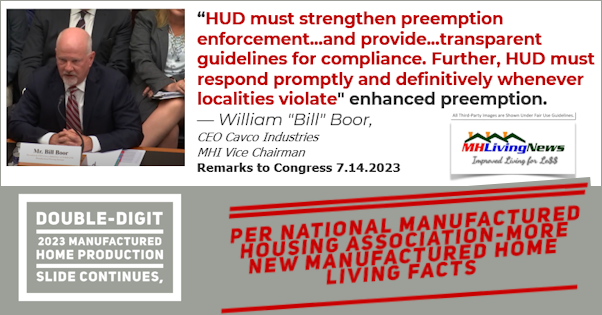
Per the linked letter from the Manufactured Housing Industry of Arizona “Addressing federal, state and local regulatory barriers to manufactured housing has never been more important. The country is facing an affordable housing shortage and manufactured housing can provide consumers with safe, high-quality and affordable homeownership options that include the features and amenities they want.” MHProNews has been reporting on remarks like that from state associations for over a decade. Another example is posted below.


That letter from the AZ state affiliate of MHI also said this.
 Combat Zoning and Restrictive Land Ordinances – HUD must exercise its preemption authority when local regulatory construction standards and zoning, planning, or development policies adversely affect the placement of quality, affordable manufactured housing. In addition to enforcing HUD’s statutory preemption authority, the Department should work with states and local governments to address state and local discriminatory zoning and development restrictions, which make it nearly impossible to site manufactured homes.”
Combat Zoning and Restrictive Land Ordinances – HUD must exercise its preemption authority when local regulatory construction standards and zoning, planning, or development policies adversely affect the placement of quality, affordable manufactured housing. In addition to enforcing HUD’s statutory preemption authority, the Department should work with states and local governments to address state and local discriminatory zoning and development restrictions, which make it nearly impossible to site manufactured homes.”
Then MHI’s executive vice president, and now MHI’s CEO Lesli Gooch, Ph.D., put it like this.

The smaller, but in some ways more notable Manufactured Housing Association for Regulatory Reform (MHARR) have hammered at the need to enforce “enhanced preemption” under the MHIA for over twenty years. On the surface, the two organizations appear to share this view in common.
Note: to expand this image and others below to a larger or full size,
see the instructions
below the graphic below or click the image and follow the prompts.


While that sampling of remarks reveals that several manufactured housing professionals believe that the MHIA’s so-called “enhanced preemption” provision is not being consistently or routinely enforced, could it be that MHI and MHARR are exaggerating or incorrect in their thinking on enhanced federal preemption?
The evidence that follows says otherwise.
- First, the failure to properly enforce the MHIA has been the subject of Congressional hearings.
- Next, the Government Accountability Office (GAO) research.
- Meaning, public officials make it clear that the issues revolving around the lack of enforcement of federal preemption are not merely some ‘conspiracy theory,’ but rather is the almost inescapable conclusion that intelligent people from across the political divide who examine the evidence have come to realize exists.
That should beg the question: given the fact that several MHI members apparently WANT the industry production limited (see examples shown above and more linked here), does years of failure involve some form of seemingly illegal collusion? Because what those remarks by MHI member brands cited above obviously indicated, several MHI members have openly stated to investors that the lack of new development of manufactured home communities – they say they think – is good for their respective business models.
That said, what that implies is that when MHI says that they want to see the industry sales grow and more private property placements or more community development they are at best paltering and posturing.
Evidence that something is amiss is supplied by MHARR. MHARR’s founding president and CEO, Danny Ghorbani, is also a former MHI vice president. Ghorbani told MHProNews that based on MHI’s own stated mission, who they collect dues from, and their own remarks, the logic is that MHI should lead the charge for legal action to compel enforcement of the MHIA’s enhanced preemption provision.

Furthermore, MHARR took a strategically keen move a few years ago when they offered to team up with an MHI affiliated state association to pick a good case and pursue legal action, if necessary, all the way to the Supreme Court. What happened? Per MHARR, there were no takers. Given the fact that MHI-linked state associations are also on record wanting to see “enhanced preemption” enforced (see some examples above), why hasn’t MHI led the charge for using the legal system to get federal preemption properly enforced?


What that exercise arguably demonstrates is this. MHI makes statements that on the surface often look similar to what MHARR has on the same issue. But when someone digs deeper, what emerges is this. MHI routinely fails to do the commonsense steps that are necessary to move from stated goals vs. actually achieving the goals they claim they want to achieve. Either MHI leaders are incredibly inept, OR they are slyly posturing and paltering one thing, while they are allowing the industry to underperform (for now) so that consolidation of the industry continues to occur.
In a related insight with respect to financing, see what MHARR’s President and CEO, Mark Weiss, told MHLivingNews with respect to Lesli Gooch’s remarks to the FHFA listening session earlier this year.
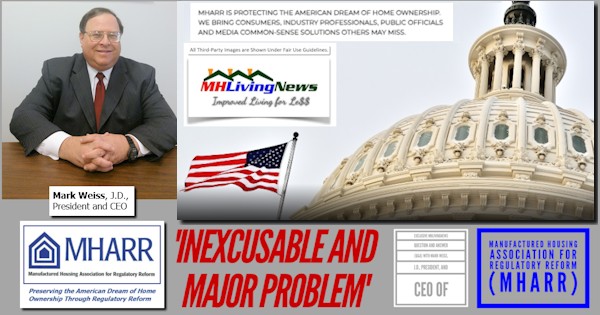
From the vantagepoint of an outsider looking into manufactured housing, attorney and law professor Daniel R. Mandelker said as part of a working paper in favor of more manufactured housing that an industry organization is needed for ‘litigation and legislative support.’ Ouch for MHI. While Mandelker didn’t mention them, he was de facto insulting their work by bluntly saying that such an organization was needed, when MHI claims to be such an organization! If MHI was doing its job properly, Mandelker – and others who have made similar observations – would not have needed to mention the need for new manufactured housing advocacy.

More on related points further below. But next, let’s look at the hard data involving manufactured housing in the 21st century as compared to where the industry was in the mid-to-late 1990s (late 20th century).
21st Century Manufactured Home Industry Production Trends
Illustration 1:
Note: to expand this image and others below to a larger or full size,
see the instructions
below the graphic below or click the image and follow the prompts.

From the Rise and Fall of HUD Code Manufactured Housing is the following.
1995 – 344,930
1996 – 363,345
1997 – 353,686
1998 – 373,143
1999 – 348,075
2000 – 250,366
2001 – 193,120
2002 – 165,489
2003 – 130,815
2004 – 130,748
2005 – 146,881
2006 – 117,373
2007 – 95,752
2008 – 81,457
2009 – 49,683
2010 – 50,056
2011 – 51,618
2012 – 54,881
2013 – 60,228
2014 – 64,334
2015 – 70,544
2016 – 81,136
2017 – 92,902
2018 – 96,555
2019 – 94,615
2020 – 94,390
2021 – 105,772
2022 – 112,882
Some Relevant Definitions
To further set the table for this factual and evidence-based discussion, a series of definitions will help many readers to better understand the issues involved. The headline asked the question: ‘Have Manufactured Housing Institute Leaders Defrauded Scores of Their Own Members?’ With that inquiry in mind, let’s consider these definitions.
- According to Oxford Languages, racketeering is a noun which means “dishonest and fraudulent business dealings.”
- Per left-leaning Wikipedia, market manipulation means: “In economics and finance, market manipulation is a type of market abuse where there is a deliberate attempt to interfere with the free and fair operation of the market…”
- Can coordinated market manipulation violate RICO and antitrust laws in U.S.? Per the U.S. Department of Justice (DOJ) website: “Under the Sherman Act, agreements among competitors to fix prices or wages, rig bids, or allocate customers, workers, or markets, are criminal violations.”
- The Federal Trade Commission (FTC) website states: “Anticompetitive practices include activities like price fixing, group boycotts, and exclusionary exclusive dealing contracts or trade association rules, and are generally grouped into two types: agreements between competitors, also referred to as horizontal conduct.”
- Kohn, Swift, and Graf stated: “Market allocation is a form of agreement not to compete. Agreements not to compete that unreasonably hinder competition may violate both federal and state antitrust laws.”
- CRF-USA.org’s post entitled: Progressives and the Era of Trust Busting said the Sherman Act: “…outlawed “every contract, combination in the form of trust or otherwise, or conspiracy in restraint of trade.” The Sherman Act also made it a crime “to combine or conspire . . . to monopolize any part of the trade or commerce among the several states.”
- BusinessJournalism.org in a post on 2.6.2023 entitled: “In Antitrust We Trust: What Happens When Companies Get too Big?” said the following: “… massive companies may be in violation of antitrust laws, meaning their business practices “unreasonably deprive consumers of the benefits of competition.” As these companies take over the markets, they’re able to drive up prices, forcing out smaller competitors and locking in consumers no matter what they choose…”
- “To violate RICO, a person must engage in a pattern of racketeering activity connected to an enterprise. The law defines 35 offenses as constituting racketeering, including gambling, murder, kidnapping, arson, drug dealing, bribery. Significantly, mail and wire fraud are included on the list.” That was posted on 10.15.2023 on the legal site Justia. Note that mail and wire fraud can include a deceptive use of the internet and email. As Bing AI said on that point: “Racketeering activity includes a wide range of criminal offenses, including mail and wire fraud, which can be committed through the use of the mails, email, or the internet 12. Therefore, if a person or group of people uses the mails, email, or the internet to commit mail or wire fraud as part of an ongoing criminal organization, they can be charged with violating RICO laws.”
- OJP.gov explains RICO like this: “The Racketeer Influenced and Corrupt Organizations Act (RICO) of 1970 seeks to strengthen the legal tools in evidence gathering by establishing new penal prohibitions and providing enhanced sanctions and new remedies for dealing with the unlawful activities of those engaged in organized crime.”
Whatever the Manufactured Housing Institute (MHI) once was in the late 20th or early 21st century, an evidence-based argument can be made that it has since been slyly controlled by a group of firms openly colluding to consolidate the industry in a manner designed to monopolize the market in an oligopoly-style manner.
“A monopoly and an oligopoly are market structures that exist when there is imperfect competition. A monopoly is when a single company produces goods with no close substitute, while an oligopoly is when a small number of relatively large companies produce similar, but slightly different goods,” per Investopedia.
If MHI leaders are authentically acting on behalf of “all segments” of the manufactured home industry, then there are obvious steps that ought to have been taken years ago to secure the manufactured home industry’s rights under federal law. But those steps have demonstrably not been taken. In some instances, some of MHI’s own past leaders and own past behaviors have been erased from their own website. Why? Would it be too embarrassing for their true goal to keep the industry underperforming so that a relatively few consolidators can steadily achieve their objectives? MHI leadership and attorneys have repeatedly declined to respond to these evidence-based concerns.
Once MHI’s stated goals on behalf of “all segments” of the manufactured housing industry are considered, and the stated importance of consolidation from MHI’s own members in their investor relations presentations are rhetorically laid side by side, the MHI’s claims stand in stark contrast to the goals of MHI members who want to consolidate the industry.
It is noteworthy that several of the consolidation steps in the production sector of the manufactured home industry that have occurred in past decade have been of MHARR members. MHARR has been the national association thought-leaders in spotlighting key issues. They have also been the voice that has called for legal action when necessary in order to enforce the industry’s long-overdue rights under federal law. See the linked reports or the MHARR website for more details on their call for Congressional and agency probes to address years of talk without proper follow up actions. If MHI’s consolidators could successfully eliminate MHARR through attrition, then a key bulwark for the authentic vs. the ersatz or merely posturing efforts at MHI that seem to sound similar to MHARR, then the battle for those who seek consolidation now vs. growth now may largely be won.

But there are other indirect pieces of evidence that MHI’s consolidators, who dominate their board of directors and are the larger members in that trade group and are often also the dominating members at the manufactured home state association level too. For example, MHI’s CEO, Lesli Gooch, Ph.D., has been documented to have significant conflicts of interest. If MHI’s corporate-board leaders authentically wanted robust manufactured home industry growth, as they too have sometimes postured, then it would seem prudent to ask for the resignation of Gooch and/or to terminate her for cause due to those conflicts of interest. But that has not occurred. See the examples linked below.
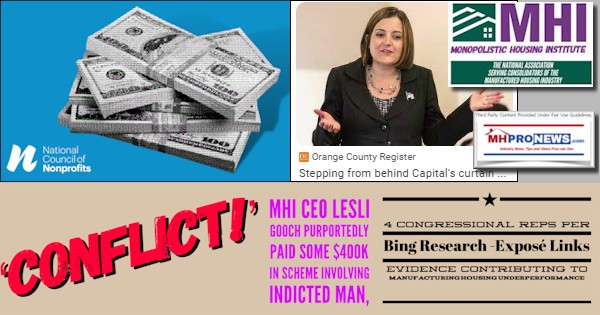

The documentary evidence for this has been known for at least some 3 years, since MHProNews first broke the story (see documents in the report below). Yet in all that time, no action has been taken against Gooch’s apparent conflicts of interest? Isn’t that an obvious failure on the part of board members who are supposed to be protecting the interests of “all segments” of the manufactured housing industry? An understanding of Gooch, paltering, phony posturing, and the “razzle dazzle” of getting Gooch ‘nominated’ for a woman of influence award are part of the arguably artful – yet ultimately unconvincing – efforts to make it seem that Gooch and MHI leaders are properly doing their jobs. The data shown above and the array of critiques show otherwise. Indeed, as evidence in the reports linked above illustrate, MHI has for years ignored the obvious allies that they could have in MHARR and with manufactured home consumers advocacy groups who want – for example – more competitive lending to become a reality.

The lack of competitive lending has been cited for years by voices such as the Urban Institute as limiting the industry’s growth. More on that in the next segment, but for now, note that a 2023 op-ed by attorney Andrew Justus for the Niskanen Center for Housing Policy have served to illustrate the concerns raised by MHARR, MHLivingNews, MHProNews and others.

MHI leaders can’t have it both ways. They can’t both claim to have a wonderful leader in CEO Gooch, and yet admit that some of their years of efforts have been apparent failures.

Restated, this is not mere garden variety failure that is occurring at MHI. The growing evidence should make clear that a systematic effort has been underway that has had the effect of blunting manufactured housing from within. As will be shown in the next segment, blunting industry growth ironically fosters consolidation and may in some cases do so at a discounted valuation for the company/business interest being consolidated. Given this understanding, a prima facie examples of antitrust violation shown herein will be part of an ongoing pattern, so that there is no statute of limitations on the apparent antitrust violating offense.
Note: to expand this image and others below to a larger or full size,
see the instructions
below the graphic below or click the image and follow the prompts.
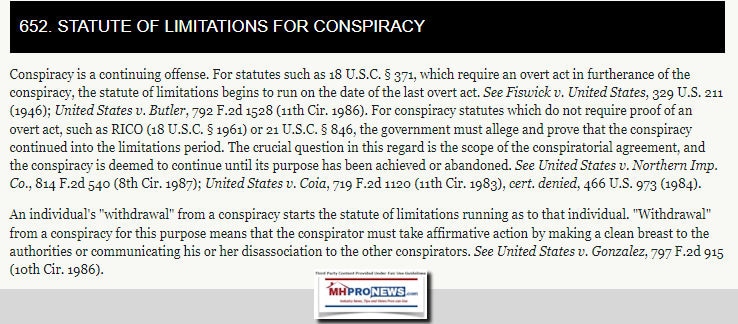
As has already been noted herein, there are several direct and indirect examples of concerns raised by industry outsiders and industry insiders. So, it must not be thought that these concerns only arise from specific competitors to MHI and/or MHI’s consolidators.
Allegations by Lawmakers, Economists, Legal Researchers – What AI Reveals
Allegations have come, over the years, that various firms, organizations, individuals, and groups that violations of federal and/or state laws have been occurring in the manufactured housing industry.
Those allegations of apparent violations of antitrust and other laws have included Congressional lawmakers, various legal researchers, Minneapolis Federal Reserve economists, and others including this writer.
Some researchers have pointed out the problems facing manufactured housing – and while they may not name or even consider MHI as part of the problem, the very subjects that they raise indirectly point to issues that MHI claims that they are working to resolve. The indirect but pointed example of law professor Daniel R. Mandelker has already been mentioned.
Nonprofits have been specifically and credibly accused of participating in these market-manipulating schemes.
The fact that the current CEO of MHI has been credibly accused with documentary evidence of conflicts of interest and has faced no apparent discipline or removal is perhaps indirect evidence that the powers that be at MHI like and want the status quo of an industry that is underperforming, regardless of what MHI staff does or says.
Which begs the question: what would be the motivation for corporations in the manufactured housing industry to desire underperformance at this time? In a word: consolidation.
To illustrate, the Masthead on MHProNews asked Bing AI the following.
“Is it easier to consolidate an industry that is underperforming or one that is growing?”
 Consolidation is a process that occurs when certain industries become less fragmented, usually enabling a handful of companies to yield power through mergers or acquisitions 1. The motives for consolidation mirror those for most M&A transactions: increasing market share, increasing buyer power, and synergies 1. Consolidation usually happens in fragmented industries, where market participants or investors see that there is significant value to be added from consolidating 1.
Consolidation is a process that occurs when certain industries become less fragmented, usually enabling a handful of companies to yield power through mergers or acquisitions 1. The motives for consolidation mirror those for most M&A transactions: increasing market share, increasing buyer power, and synergies 1. Consolidation usually happens in fragmented industries, where market participants or investors see that there is significant value to be added from consolidating 1.
Learn more:
The problem for a serial liar and poser was identified over a century and a half ago by Abraham Lincoln.

A more succinct version of this argument was made to the FHFA during a presentation where MHI was present. They did not bother to respond.

The quotation collage that follows was updated in August, 2023. MHI leaders were given opportunities to respond. They declined. But note that MHI previously repeatedly threatened this publication with legal action. They warned us through an outside attorney’s letter (John Greiner, J.D.) not to quote their remarks without their permission (laughable, but true). MHProNews and MHLivingNews kept doing so. They have never sued.
Note: to expand this image and others below to a larger or full size,
see the instructions
below the graphic below or click the image and follow the prompts.


Summing Up and Conclusion
No one with the education and experience of MHI’s staff and corporate leadership could be so incompetent as to allow manufactured housing to underperform so badly during an affordable housing crisis.
Per MHARR on November 3, 2023: “September 2023, a 15.2% decrease from the 9,381 new HUD Code homes produced in September 2022. Cumulative production for 2023 is now 66,647 homes, a 25.7% decrease from the 89,812 homes produced over the same period during 2022.” Annualizing that pace would yield 88,862 new HUD Code homes for 2023. But as noted and linked above, MHI CEO Stinebert said in 2004 that the industry had bottomed out and was headed up again. That year – 2004 – the manufactured home industry produced 130,748 new homes. In 1998 the industry collectively produced some 373,143 new HUD Code manufactured homes. So, this year at the current pace may finish at less than 24 percent of the total in 1998, even though the U.S. population has grown, and millions of manufactured homes are needed.
If MHI leaders are guilty of colluding with each other on some level to keep the manufactured housing industry underperforming so as to foster consolidation, then MHI has made an arguably fraudulent pitch to their members for years. That pitch involved emails and the internet, which means they could be accused of RICO violations as well as market manipulation or antitrust violations.
Our firm was one of those members for some years, and every dime spent on membership, travel, meeting costs, etc. was wasted. Not even thinking about lost opportunity costs, for a modest firm such as ours, the loss costs of MHI membership might be in the range of $100,000. Meaning, when those costs are multiplied by the total number of firms impacted by MHI’s apparently deceptive racket could have a direct cost of millions of dollars for all of the firms similarly harmed.
But the losses to the industry in terms of lost production could have been in the tens if not a hundreds of billion dollars plus. Taxpayers often footed that bill and more because of money spent on subsidized housing, homelessness, and the like.
Then there are the impacts on residents hit by artificially higher site fees in land-lease communities.
Then there are billions lost by potential manufactured homeowners who might have been making payment and building equity in a manufactured homes instead of piling up rental receipts.
Given the premise of proof beyond a reasonable doubt (criminal law standards) and/or proof based on the preponderance of evidence (civil law standards), the majority of the American public has been harmed by the ripple effects of market manipulation.
It is an open question if the Biden White House Fact Sheet was serious or posturing. But even if it was paltering and posturing, it made some relevant points. Quoting:
- For decades, corporate consolidation has been accelerating. In over 75% of U.S. industries, a smaller number of large companies now control more of the business than they did twenty years ago.
- That lack of competition drives up prices for consumers.
- Barriers to competition are also driving down wages for workers.
- Inadequate competition holds back economic growth and innovation.
- When past presidents faced similar threats from growing corporate power, they took bold action.
- In total, higher prices and lower wages caused by lack of competition are now estimated to cost the median American household $5,000 per year.”
Antitrust author Matt Stoller said this on 11.14.2023: “Americans oppose monopolies and support antitrust laws, which isn’t a surprise. People dislike junk fees and unfair prices.” Stoller added: “That holds among both Biden and Trump voters, with more than 70% of both camps agreeing that monopolies are bad for the economy. And only 5% of Americans – across party affiliations – think that antitrust laws should be weakened.” Stoller cited this survey.

The Biden White House cited both Democratic and Republican presidents as examples of antitrust action. Quoting again:
In the early 1900s, Teddy Roosevelt’s Administration broke up the trusts controlling the economy—Standard Oil, J.P. Morgan’s railroads, and others—giving the little guy a fighting chance. In the late 1930s, FDR’s Administration supercharged antitrust enforcement…”
Ironically, Schmitz and his colleagues cited the FDR era as an example of how ‘sabotaging monopoly’ tactics were identified in that era. Schmitz et al said that conventional builders and HUD have sabotaged manufactured housing from early on. But Schmitz also mentioned in passing what Strommen went into far more detail on. Namely, the efforts within manufactured housing to foster oligopoly style monopolization. To see that argument, see the linked report below. ###


[cp_popup display=”inline” style_id=”139941″ step_id = “1”][/cp_popup]

Stay tuned for more of what is ‘behind the curtains’ as well as what is obvious and in your face reporting that are not found anywhere else in MHVille. It is all here, which may explain why this is the runaway largest and most-read source for authentic manufactured home “News through the lens of manufactured homes and factory-built housing” © where “We Provide, You Decide.” © ## (Affordable housing, manufactured homes, reports, fact-checks, analysis, and commentary. Third-party images or content are provided under fair use guidelines for media.) (See Related Reports, further below. Text/image boxes often are hot-linked to other reports that can be access by clicking on them.)

By L.A. “Tony” Kovach – for MHProNews.com.
Tony earned a journalism scholarship and earned numerous awards in history and in manufactured housing.
For example, he earned the prestigious Lottinville Award in history from the University of Oklahoma, where he studied history and business management. He’s a managing member and co-founder of LifeStyle Factory Homes, LLC, the parent company to MHProNews, and MHLivingNews.com.
This article reflects the LLC’s and/or the writer’s position, and may or may not reflect the views of sponsors or supporters.
Connect on LinkedIn: http://www.linkedin.com/in/latonykovach
Related References:
The text/image boxes below are linked to other reports, which can be accessed by clicking on them.














